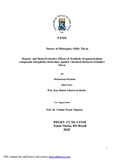| dc.creator | Ibrahim, Mohammad | |
| dc.date.accessioned | 2021-08-26T18:43:32Z | |
| dc.date.available | 2021-08-26T18:43:32Z | |
| dc.date.issued | 2010-06-16 | |
| dc.identifier.uri | http://repositorio.ufsm.br/handle/1/22079 | |
| dc.description.abstract | The liver presents extraordinary functional diversity, particularly in the control of energy
production, immune defense and volemic reserve. The human being is exposed
occupationally and in the environment to a variety of hepatotoxic compounds, such as the
use of paints and their derivatives (2-nitropropane, 2-NP), chemical reagents (glycerol) and
exposure to cigarette (2-NP). Therefore, it is interesting, the study of therapies to prevent or
even reverse the poisoning caused by these compounds. Considering, that reactive oxygen
species (ROS) have an important role in various diseases, especially in liver and kidneys
diseases, the use of antioxidant therapies should be considered. The interest in
organoselenium biochemistry and pharmacology has increased in the last two decades due
to a variety of organoselenium compounds that possess biological activity. Previously our
research group, have demonstrated that diphenyl diselenide had hepatoprotective effects
against 2-NP. However, no studies are available regarding the effect of the size of the
organic moiety of diselenides on the hepatotoxicity of 2-NP. Consequently, in view of the
literature data indicating the strong influence of the organic moiety of diselenides on their pharmacological, toxicological and biological activities and the limited data about the
effect of the aromatic ring on the biological activities of diselenides, therefore in this study
we investigated the antioxidant activity of binaphthyl diselenide in models of oxidative
damage in vivo in rats liver and kidneys. Our results shows that the potential antioxidant
activity of binaphthyl diselenide ((NapSe)2; 50 mg/kg, p.o.) against the 2-NP-induced
hepatoxicity in rats, using different end points of toxicity (liver histopathology, plasma
aspartate aminotransferase (AST), alanine aminotransferase (ALT) and creatinine). In
addition, in view of the association of oxidative stress with 2-NP exposure, hepatic lipid
peroxidation, ascorbic acid levels, δ-aminolevulinate dehydratase (δ-ALA-D) and catalase
(CAT) activities were evaluated. 2-NP caused an increase of AST, ALT and hepatic lipid
peroxidation, also caused hepatic histopathological alterations and δ-ALA-D inhibition.
(NapSe)2 (50 mgkg_1) prevented 2-NP-induced changes in plasmatic ALT and AST
activities and also prevented changes in hepatic histology, δ-ALA-D and lipid peroxidation.
Results presented here indicate that the protective mechanism of (NapSe)2 against 2-NP
hepatotoxicity is possibly linked to its antioxidant activity. Similarly binaphthyl diselenide
protected against oxidative damage on glycerol-induced renal damage in rats. So Adult
male Wistar rats were treated with (NapSe)2 (50 mgkg_1, p.o) or vehicle. After 24 h
(NapSe)2 treatment, the animals received an intramuscular injection of glycerol (8ml/kg,
dissolved in saline) or vehicle as a divided dose into the hind limbs. Twenty-four hours
afterwards, rats were euthanized and the levels of urea and creatinine were measured in
plasma. Non-protein thiol (NPSH) levels and catalase (CAT) activity were evaluated in
renal homogenates. Histopathological evaluations were also performed in kidneys of rats.
The rats exposed to glycerol presented swelling of the proximal and distal tubules with evidence of cell damage and death. Glycerol-exposed rats presented an increase in renal
failure markers (plasmatic urea and creatinine levels) and a reduction in renal CAT activity.
No change was observed in NPSH levels in kidneys of rats exposed to glycerol. (NapSe)2
protected against the alterations caused by glycerol in rats. (NapSe)2 increased per se NPSH
levels (33%) in kidneys of rats. The results demonstrated that treatment with (NapSe)2
protected against renal damage induced by glycerol in rats, probably due to its antioxidant
effect. Based on these results, we can conclude that, the binaphthyl diselenide administered
orally at a dose of (50 mgkg_1) did not cause toxicity in rats.The binaphthyl diselenide was
effective in protecting against liver damage induced by 2-NP in rats. The binaphthyl
diselenide was effective in protecting against renal damage induced by glycerol in rats. The
precise mechanisms that may be involved in protection and the pharmacological action of
organoselenium against 2-NP induced hepatotoxicity and glycerol-induced renal demage
are yet to be fully understood. However the present study holds great promise that
organoselenium compounds are first line candidates in the management of these diseases. | eng |
| dc.language | por | por |
| dc.publisher | Universidade Federal de Santa Maria | por |
| dc.rights | Attribution-NonCommercial-NoDerivatives 4.0 International | * |
| dc.rights.uri | http://creativecommons.org/licenses/by-nc-nd/4.0/ | * |
| dc.subject | Liver damage | eng |
| dc.subject | Selenium | eng |
| dc.subject | Binaphthyl diselnide | eng |
| dc.subject | Glycerol | eng |
| dc.subject | 2-nitropropane | eng |
| dc.title | Hepato- and reno-protective effects of synthetic organoselenium compound, binaphthyl diselenide, against chemical-induced oxidative stress | por |
| dc.type | Tese | por |
| dc.description.resumo | Não possui resumo em português. | por |
| dc.contributor.advisor1 | Rocha, João Batista Teixeira da | |
| dc.contributor.advisor1Lattes | http://lattes.cnpq.br/3935055744673018 | por |
| dc.contributor.advisor-co1 | Nogueira, Cristina Wayne | |
| dc.contributor.referee1 | Puntel, Robson Luiz | |
| dc.contributor.referee2 | Alves, Diego da Silva | |
| dc.contributor.referee3 | Oliveira, Mauro Schneider | |
| dc.contributor.referee4 | Brandão, Ricardo | |
| dc.creator.Lattes | http://lattes.cnpq.br/2489831244715668 | por |
| dc.publisher.country | Brasil | por |
| dc.publisher.department | Bioquímica | por |
| dc.publisher.initials | UFSM | por |
| dc.publisher.program | Programa de Pós-Graduação em Ciências Biológicas: Bioquímica Toxicológica | por |
| dc.subject.cnpq | CNPQ::CIENCIAS BIOLOGICAS::BIOQUIMICA | por |
| dc.publisher.unidade | Centro de Ciências Naturais e Exatas | por |



